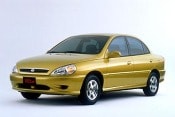
1. Kia Rio
Introduced for 2001, the subcompact Rio sedan (and later in the year, a wagon) competes with the Hyundai Accent, Daewoo Lanos and Toyota Echo, all of which made this list, as well. Alongside its distinction as the price leader of this group, we must also tell you that the Rio is the weakest, at least where driving is concerned (save for the Suzuki Swift). Powered by a 96-horsepower 1.5-liter four-cylinder, the Rio is besieged by a dearth of off-the-line power, massive torque steer (that is, the front wheels break right or left during acceleration), a weak suspension and an extremely vague shifter. Once the Rio does reach highway speeds, however, it holds them rather well and even has juice left for passing. While interior materials are low-budget, the Rio's cabin has a logical layout and a few surprisingly nice features, such as seat cushion tilt and height adjustment and a driver's armrest. The option list includes ABS, air conditioning and a cassette or CD player, but you can't have power windows or locks. You'll note that the Rio's wedge-shaped exterior is attractive if generic — each one comes with upscale-looking clear lens headlights and, with the reasonably priced upgrade package, wheel covers and bodyside moldings. Snazzy alloy wheels are available as an inexpensive option, and you can get a nifty spoiler for the deck lid, too. That said, you should only consider a Rio if you have no money and you've decided that you must have a new-car warranty. Otherwise, take our associate editor's advice: get a used Honda Civic and have it detailed.
See Edmunds pricing data
Has Your Car's Value Changed?
Used car values are constantly changing. Edmunds lets you track your vehicle's value over time so you can decide when to sell or trade in.

After a shaky period in the early 1990s (remember the Excel?), Hyundai has worked hard to reinvent itself by building the current Elantra, Santa Fe, Sonata and XG300 and backing them up with the industry's longest drivetrain warranty (10 years/100,000 miles). The Accent is also part of the company's plan. After a redesign in 2000, the thrifty hatchback and sedan received a more powerful engine for 2001. The Accent is available in three trim levels — base L and midlevel GS are hatchbacks, and uplevel GL is a sedan. The new 1.6-liter DOHC four-cylinder engine makes 105 horsepower and 106 foot-pounds of torque; it is standard in GS and GL models and optional for the L hatchback (which has the previous year's 92-horsepower 1.5-liter SOHC four as its standard powerplant). The larger engine actually provides better fuel economy, too. A capable automatic transmission is available but only for the GS and GL. While the Accent isn't rewarding to drive, it provides acceptable levels of power and handling for basic commuting. However, if you push the car at all, its weak tires quickly give up, and its suspension allows plenty of body lean. The tires are the main detractor from the Accent's handling, and they compromise braking performance, as well. Standard equipment for the L hatchback includes a cassette player, rear defroster, trip odometer and power steering. GS and GL models get upgraded carpeting, a digital clock, a tachometer, lumbar support for the driver, a 60/40 folding rear seat, a passenger visor vanity mirror and tinted glass. Upgraded trims also open the door to the few factory options that are available, such as power front windows, power exterior mirrors, air conditioning and a CD player. Of course, you can also put port-installed options on any Accent (that is, carpeted floor mats, a rear spoiler, a center armrest, mudguards and a cargo net for the trunk). You'll note that ABS and cruise control are not on either option list. Our main reservation about the Accent has nothing to do with the way it drives, but with its welterweight 2,280 pounds — it simply doesn't offer much crash protection from the hulking SUVs and pickups on the road.
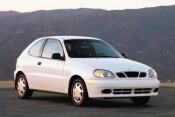
3. Daewoo Lanos
Daewoo has struggled to win customers in the United States, and the company's well-publicized financial problems haven't helped. The Lanos is the smallest and least expensive of Daewoo's current offerings, and it competes with the Kia Rio, Hyundai Accent and Toyota Echo. Buyers can choose from three versions: the frugal S hatchback, the mid-priced S sedan and the significantly more expensive Sport hatchback (which also comes with more options). Every Lanos is powered by an unrefined 1.6-liter DOHC four-cylinder, which makes 105 horsepower and 106 foot-pounds of torque — and thrashes unhappily at higher revs. Stiff suspension tuning from Porsche somewhat atones for the whiny powerplant whenever you toss the car around a corner. Lanos benefits from styling by ItalDesign, and its paint positively shimmers. Elsewhere, fit and finish is quite good. But the dash is made of what appears to be the least expensive plastic on the planet, and it doesn't include a tachometer. You can option the S hatchback and sedan with a premium package that includes power windows, power door locks, power passenger-side rearview mirror, tilt steering wheel, CD player, digital clock and variable intermittent wipers. The Sport model includes many of these goodies, plus red leather and brushed aluminum interior trim, alloy wheels, side skirting and a rear spoiler. What's missing is — you guessed it — more power. An automatic transmission is available at all trim levels, but as with the Hyundai Accent, you'll have to forgo ABS and cruise control. The base Lanos hatchback delivers a small package with a price to match. However, no-haggle pricing, Daewoo's financial instability and the Lanos' unproven reliability leave us unable to recommend it. In most cases, prospective buyers would be better off with a slightly used vehicle from one of the major Japanese manufacturers.
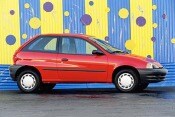
4. Suzuki Swift
2001 is the last year for the tiny Swift hatchback, but that doesn't mean we think you should rush out to grab one in hopes of scoring a future collectible. The Swift is from an earlier era when new car buyers with extremely limited budgets had few options, other than strippo cars with engines barely worthy of personal watercraft. Certainly, that description does justice to the Swift. Its tiny 1.3-liter four-cylinder engine generates just 79 horsepower at 6,000 rpm and 75 foot-pounds of torque at 3,000 rpm. A base Swift GA can't even be optioned with power steering. You can't have a stereo, air conditioning or ABS, either. Move up to the GL trim level, and you'll get a stereo with a mere two speakers and air conditioning but still no power steering or ABS — and you're looking at an MSRP of well over $10,000. The only factory-installed option for the Swift is a three-speed automatic transmission. Suzuki dealerships can install a CD player to make the car more hospitable, and interestingly, every Swift is equipped with daytime-running lights. The best thing about the Swift? Fuel economy. In this price range, only the Echo comes close to the Swift's 36 mpg in the city and 42 on the highway. Its reliability record is encouraging, as well — and it better be, because the warranty is short and doesn't include roadside assistance. We can't think of a good reason to put hard-earned dollars into a Swift and would instead propose a solid used vehicle, preferably one from a major Japanese manufacturer.
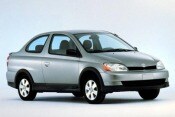
5. Toyota Echo
As the fifth car on our list of budget cars, the Echo would seem to represent a good value for buyers in the economy subcompact segment. It has a more powerful, more sophisticated engine than any of the first four cars and, as a Toyota, its prospects for longevity are much better. But its value is a ruse. The base Echo is as stripped as a Swift, and when you start adding options, you can easily spend $14,000 to $15,000. And once you reach this level, there are far better cars available — a Nissan Sentra, Hyundai Elantra, Ford Focus, Honda Civic, Mazda Protege or even Toyota's own Corolla would be a much better buy. The squat Echo comes as a coupe or sedan with an energetic 1.5-liter VVT-i four-cylinder good for 108 horsepower and a manual or automatic transmission. While acceleration and braking are surprisingly good, handling is another matter. Indeed, the short wheelbase and softly sprung suspension are well-suited to tightly packed urban areas with crumbling pavement, but on the freeway, the Echo tends to "hobby-horse" and wag its tail — which leads to instability and white knuckles. Also, with its tall stance, light curb weight and slab-sided bodywork, the Echo is quite susceptible to crosswinds. The interior is roomy and has plenty of storage, though you'll have to get used to a center-mounted speedometer and the absence of a tach. Both Echo models come with a four-speaker stereo, but power steering, air conditioning, power locks, a rear defroster, ABS and a CD player are all extras. Even if you option the car with everything, you'll be rolling down your own windows and manually adjusting your own mirrors. And this is ridiculous. Any of the cars above give you these features. Even a Hyundai Accent can give you these features. If you're determined to buy a Toyota, a gently used Corolla (or its twin, the Chevy Prizm) will probably make you much happier.
Saturn's line of small cars has gained quite a following over the last decade — and what's not to like? S-Series cars are reliable, and the dealerships that sell them emphasize the ownership experience in addition to the taking-your-money experience. However, given the competition in the economy segment (think Civic, Elantra, Focus, Sentra and Protege) and the pricing for uplevel S-Series models, we think Saturn can do better. Much better. The $11,035 MSRP for the base SL sedan is the reason the S-Series is on this list. It has a short list of standard equipment, but you can option it with air conditioning, ABS with traction control, head curtain airbags and a CD or cassette player. Moving up to the SL1 sedan makes you eligible for more of the fun stuff like a power sunroof, remote keyless entry and power windows, locks and mirrors. The real packaging problem has to do with engine choices. If you're an SL, SL1 or SC1 coupe buyer (the coupes have a nifty third door, by the way), you can only have a miserable 100-horsepower 1.9-liter four-cylinder engine. The 124-horse, twin-cam version of this powerplant is only available to SL2, SC2 and SW2 wagon buyers. Even the more powerful engine feels lethargic with an automatic transmission, so we would encourage you to stick with a manual if possible. Unfortunately, the upper trim levels command a large premium — an SC2 coupe starts at $16,110 and quickly closes in on 17 large if you add an automatic. Handling, even with the sport suspension standard on the SL2 and SC2, is only so-so. The poorly assembled interiors are not at all friendly — the seats are uncomfortable, ergonomics are poor and materials are low-grade. While many competitors have focused on making economy buyers feel as if they didn't buy an economy car, the S-Series offers no illusions of what it isn't.
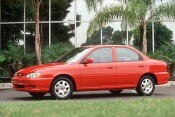
7. Kia Sephia
Competitive pricing has helped the Sephia attract buyers in the compact sedan market. Upscale styling tweaks and unusually good build quality help the car transcend its budget status. However, the Sephia scores well below average for initial quality, according to J.D. Power and Associates' owner surveys. The car is equipped with a 125-horsepower 1.8-liter engine and a manual transmission; a responsive four-speed automatic is optional. The engine's 108 foot-pounds of torque allow the car to scoot away from stoplights, but passing power is limited. A capable Lotus-tuned suspension is no match for the Sephia's cheap tires — handling is sloppy on curvy roads. The front disc/rear drum brakes, available with ABS on LS models, won't help in this regard, proving weak and generally ineffective with lousy pedal feel. Besides its great price and its industry-leading warranty, the Sephia's greatest strength is its spacious interior, which really can accommodate four adults. Base equipment on the Sephia includes power steering, four-wheel independent suspension with front and rear stabilizer bars, wheel covers, dual exterior mirrors, theft-deterrent system, rear defogger, cassette stereo, 60/40 split-folding rear seat and fabric upholstery. The upgraded LS adds air conditioning, power windows and door locks, bodyside moldings, tilt steering wheel and a driver seat cushion tilt feature. Buyers can add wood grain dash appliques, a rear spoiler and floor mats to any Sephia, but goodies like cruise control, alloy wheels, power mirrors and ABS are limited to the more expensive LS. Unimpressive mechanicals and a poor reputation for quality will deter some buyers, while a low price and a killer warranty will attract others. The Sephia isn't a great car, but if you must have a new car with a warranty, it may be a good bargain.
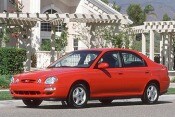
8. Kia Spectra
Five-door hatchbacks are making a return in the U.S. — but as one of the earliest manufacturers to re-test Americans' fancies, Kia made sure that its sporty Spectra didn't really look like a hatchback. And that's part of its appeal — it's a sedan with the convenience of a rear hatch. The Spectra is based on the Sephia, and it offers a similarly roomy interior (though its canted rear glass makes the backseat tighter). Powered by a Sephia-derived, 125-horsepower, 1.8-liter DOHC four-cylinder engine and mated to a standard five-speed manual gearbox (a four-speed automatic is optional), the Spectra provides decent fuel economy (23 city and 29 highway) but lacks capable acceleration off idle and during passing maneuvers. Additionally, the raucous motor makes an incessant whine at higher revs, which can grate on the driver's nerves. Handling characteristics are much like the Sephia's. Body roll is kept in check, and steering is responsive. Cheap tires ruin the fun on curvy roads. On the highway, the Spectra smoothes out any pavement irregularities, but floats like a boat over highway expansion joints despite its Lotus-tuned suspension. Front disc/rear drum brakes are barely adequate, requiring lots of pedal pressure that results in mediocre stopping performance. The interior has a usable layout and relatively comfortable seats, but the quality of the materials is substandard for this price range. Two trim levels are available: GS and GSX. The sparsely equipped GS includes fabric upholstery, split-folding rear seat, cassette player, rear defroster and two-speed wipers. Optional equipment includes air conditioning, body-color side moldings, rear wiper/washer, floor mats and an automatic transmission. GSX adds alloy wheels, a rear spoiler, tape stripes and special fabric for a sporty look. It also provides power windows and locks, air conditioning and a tilt steering wheel. ABS, a CD player, cruise control and power windows and mirrors are available only on the GSX. As with the Sephia, lackluster mechanicals may kill your enthusiasm. But the Spectra delivers a low price, a great warranty and aggressive fastback styling.
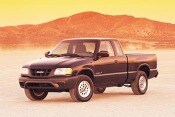
9. Isuzu Hombre
Here it is, the least expensive pickup on the market. Did you even know that Isuzu made a pickup? Actually, it isn't really an Isuzu. It's a rebadged Chevrolet S-10/GMC Sonoma pickup, and interestingly, Isuzu will design the 2003 replacement for the current-generation S-10/Sonoma. Anyhow, the current Hombre isn't very popular, and it will only appeal to those who want a work truck and don't mind the S-10's shortcomings — lousy build quality, interior materials, crash test scores and reliability record. You won't find any crew cabs or sporty Xtreme package trucks at Isuzu dealerships, though, just the regular cab and the "SpaceCab" (that is, extended cab). If you buy a two-wheel-drive model, you get the anemic 2.2-liter inline four, which spews just 120 horsepower and 140 foot-pounds of torque — you would probably do well to keep the standard manual transmission. Four-wheel-drive models fare better as they get GM's strong Vortec 4300 V6 good for 190 horsepower and 250 ft-lbs of twisting force. All models are equipped with a heavy-duty suspension. The regular-cab versions are available in S and XS trim levels, and options are few. S models are the workhorses, with vinyl floor covering and limited options that include air conditioning, stereo and a rear step bumper. Hombre XS models are better equipped, offering custom cloth upholstery, carpeted floors and a tachometer. SpaceCab models also come in S and XS trim, providing vinyl folding jump seats in the rear and easy-entry seats in the front. If ordered with the optional third door, the truck comes equipped with only one jump seat. Four-wheel ABS, battery-rundown protection, auto on/off headlamps and a theft-deterrent system are standard on all models. Four-wheel-drive Hombres also get standard alloy wheels. If you're on a limited budget and must have a brand-new work truck, the Hombre may work for you. A better option would be a slightly used Toyota Tacoma or Nissan Frontier.
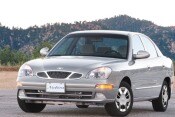
10. Daewoo Nubira
The Nubira is the most promising member of Daewoo's current lineup in the United States. Nubira competes in the economy sedan segment (Civic, Elantra, Sentra and the like) and manages to deliver a lot of standard content for a low price. The Nubira is available in two trim levels and body styles: Sedans come in SE and CDX trim, while wagons are only available as loaded CDX models. The base SE comes with a height-adjustable driver seat, six-speaker sound system with cassette player and four-wheel disc brakes. The optional convenience package adds power windows, mirrors and locks, as well as remote keyless entry, tilt steering wheel, a car alarm and fog lights. Uplevel CDX trim includes a long list of additional standards, in addition to a loaded SE. Added goodies include air conditioning (optional for SE), a CD player, alloy wheels (that resemble a Cuisinart tool), cruise control, heated exterior mirrors and antilock brakes. Leather seats and a moonroof are optional on the CDX. Wagons add a rear wiper and a roof rack. All Nubiras are covered by a scheduled maintenance policy, which takes care of oil changes, tire rotations and the like for the first year (or 12,000 miles) of ownership. A GM-designed 2.0-liter four powers each Nubira; this powerplant makes 129 horsepower at 5,400 rpm and 136 foot-pounds of torque at 4,400 rpm. It needs to be revved to reach its powerband but doesn't seem happy to do so — there's plenty of racket above 3,000 rpm. You can have a manual or an automatic transmission at any trim level. Overall, Nubira provides a pleasant ride and decent, if not downright sporty, handling as long as the driver isn't pushing the car for all it's worth. Body roll is kept to a minimum in slower turns, and steering is reasonably responsive if a bit numb. The factory tires, however, could certainly use upgrading, as could the rather weak brakes. The interior offers ample legroom for front passengers, though full use of the available dimensions compromises rear space. Interior materials are rather low-grade, but at this price, we won't complain too much. If you care about resale value or want to haggle on the sale price, Nubira isn't for you. If you can enjoy a humble car that is somewhat attractive, reasonably powerful, loaded with content and priced seductively low, then consider the Nubira.
--Based on MSRP for 2001 base models. Other close competitors include the Nissan Sentra, Nissan Frontier, Toyota Tacoma, Ford Ranger, Ford Escort ZX2 and Hyundai Elantra.


